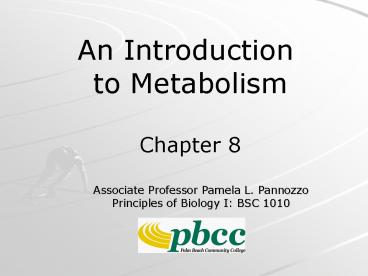The Living World Chapter 5 PowerPoint PPT Presentation
1 / 34
Title: The Living World Chapter 5
1
An Introduction to Metabolism Chapter 8
Associate Professor Pamela L. Pannozzo Principles
of Biology I BSC 1010
2
Metabolism
- Metabolism sum of an organisms chemical
reactions - Metabolic pathway a series of chemical
reactions taking place inside a cell that convert
molecules to end products - Catalyzed by enzymes
3
Metabolic Pathway
- Catabolic pathway breaks down molecules, may
release energy - Anabolic pathway builds complex molecules,
consumes energy
4
Energy
- The ability to do work
- Exists in two states kinetic and potential
Kinetic Energy energy of motion
Potential Energy stored energy
5
Forms of Energy
- Energy exists in many forms
- Mechanical, sound, light, electric, heat,
chemical, etc. - Heat (thermal) energy form of kinetic energy
associated with the random movement of molecules - Chemical energy form of potential energy held
in the bonds between atoms of a molecule
6
Laws of Thermodynamics
- The First Law
- Energy cannot be created or destroyed but it can
change forms - During each conversion, some energy is lost into
the environment as heat energy - The Second Law of Thermodynamics
- Disorder (entropy) in closed systems is
continuously increasing - Each energy transformation increases the entropy
of the universe
7
(No Transcript)
8
(No Transcript)
9
Spontaneity of Chemical Reactions
- Some chemical reactions occur spontaneously,
others occur only with an initial input of energy - Based on free energy changes
- Free Energy G the amount of energy that is
available to perform work in a cell - unstable energy
- Measure to determine if a reaction will occur
spontaneously or not - ?G ?H T?S
- H total energy
- T temperature
- S entropy
10
Spontaneity of Chemical Reactions (cont)
- Spontaneous reactions occur only if the system
gives up energy or order, or both only where ?G
is negative - Systems move toward greater stability, less free
energy, or equilibrium
11
Spontaneity of Chemical Reactions (cont)
- Exergonic reaction net release of free energy
- Occurs spontaneously
- C6H12O6 O2 ? 6CO2 6 H2O ATP heat
- ?G -686 kcal/mol
- Endergonic reaction absorbs energy from its
surroundings - Does not occur spontaneously
- Stores free energy in molecules
6CO2 6 H2O sunlight energy ? C6H12O6 O2 ?G
686 kcal/mol
12
(No Transcript)
13
The Flow of Energy in Living Things
- Sun to Autotrophic organisms
- Capture part of it (2), convert to potential
chemical energy in the bonds between atoms of
monosaccharides - Within Autotrophs and to Heterotrophs
- Heterotrophs consume autotrophs, convert
monosaccharides into a smaller molecule that
cells can use called adenosine triphosphate (ATP)
14
ATP The Energy Currency of the Cell
15
(No Transcript)
16
ATP Hydrolysis
17
Phosphorylation
18
ATP Powers Cellular Work
- Protein synthesis
- Muscle cell contractions
- Vesicular transport
19
ATP Powers Cellular Work
- Active transport
- Temperature
- homeostasis
- Ciliar/flagellar
- movements
20
ATP Powers Cellular Work
- Protein activation
- Cell shape
- changes
21
Enzymes
- Catalyze metabolic reactions that make or break
molecules - Activation energy (EA) energy needed to start a
chemical reaction - to change the shape of the molecules
- usually heat from surroundings
22
Activation Energy
23
Enzymes (cont)
- Enzymes lower EA barrier without addition of heat
- Protection of proteins
- Selective metabolic control
- Direction of catalysis determined by amount of
substrate and enzyme
24
(No Transcript)
25
(No Transcript)
26
(No Transcript)
27
Effects on Enzyme Activity
- Temperature
- pH
- Cofactors
- Enzyme inhibitors
28
(No Transcript)
29
Regulation of Enzyme Activity
- Cofactors/Coenzymes
- Metal ions or organic molecules
- Bind to enzymes or substrates
- Inhibitors
- Permanent inhibition ? covalently bonded to
enzyme - Reversible inhibition ? weakly bonded to enzyme
- Competitive inhibitors--resemble substrate
- Noncompetitive inhibitors--bind to non-active
site area, alter enzyme shape
30
(No Transcript)
31
Regulation of Enzyme Activity (cont)
- Allosteric Regulation
- proteins function at one site is affected by
binding of a regulatory molecule at another site - stimulates or inhibits enzyme
- Feedback Inhibition
- inhibits enzyme
32
(No Transcript)
33
(No Transcript)
34
Regulation of Enzyme Activity (cont)
- Specific Within-Cell Localization
- Enzyme complexes with fixed locations in the cell
- Intermembrane
- Within-organelles

